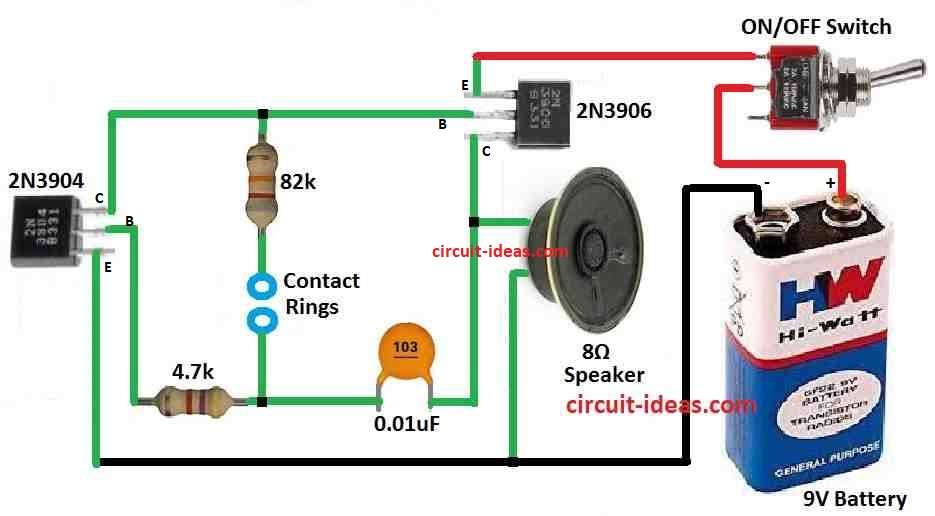Enjoy making this circuit for detecting lies!
Real lie detectors are far more complicated so it will not be perfect but it is an an entertaining method to see how our bodies respond to stress.
This circuit uses differences in sweating to figure out whether someone is speaking the truth.
People who are worried or nervous sweat more.
Warning: This should not be used for actual lie detection it is only for entertainment.
What is a Lie Detector Circuit:
A lie detector circuit also known as a polygraph or truth verification system is an electrical device designed to monitor and record bodily signs that are believed to be connected with dishonesty or lying.
The basic idea is that when someone is lying or is under stress than certain changes in their bodies occur accidentally.
These emotions are what the lie detector looks for and examines to figure out whether someone is telling the truth or lying.
The construction method and how the circuits works are shown below:
Circuit Working:

Parts List:
| Category | Description | Quantity |
|---|---|---|
| Resistors | 4.7k CFR, 82k CFR | 1 each |
| Capacitor | Ceramic 0.01µF | 1 |
| Semiconductors | Transistors 2N3904, 2N3906 | 1 each |
| Speaker 8Ω | 1 | |
| ON/OFF Switch | 1 | |
| Battery 9V | 1 | |
| Blue Rings | 2 |
The circuit activates when one places his fingertips on the blue rings and turn on the power supply.
A low frequency sound produced by the speaker indicates that fingertips are reasonably dry in a normal non stressful condition.
On the other hand when one is stressed or afraid it release little volumes of mineral and salt rich fluid from its fingertips.
This shift is quickly detected by the lie detector circuit which makes the speakers frequency tone sharper and clearer.
The tone swing indicates a great deal of tension which raises the possibility that the speaker is lying or giving misleading answers to queries.
The lie detector circuit is a useful instrument for measuring emotional reactions and revealing hidden facts because of this interesting technique.
Formula:
The formula mentioned below describes the resonant frequency of an LC circuit.
f = 1 / 2π√LC
where,
- f represents the resonant frequency of the circuit measured in hertz Hz.
- L indicates the inductance of the circuit measured in Henrys H.
- C represents the capacitance of the circuit measured in Farads F.
- π (pi) is a mathematical constant with a value of approximately 3.14159.
- √ is the symbol represents the square root.
According to the formula the square root the total value of capacitance C and inductance L measure the resonant frequency in an inverse manner.
Therefore a larger capacitance or inductance will result in a lower resonant frequency.
And also as a result a lower resonant frequency will be a result of a bigger capacitance or inductance.
Note:
This formula works for suitable LC circuits that have no resistance.
Actual circuits will always include resistance which can modify the resonance frequency and cause damping effects.
Several fields of electronics such as oscillators, filters and radio circuit tuning use the idea of resonant frequency.
How to Build:
To build a Simple Lie Detector Circuit follow the below mentioned connections steps:
Get the transistors ready:
- Put the PNP transistor 2N3906 and the NPN transistor 2N3904 in the correct places first.
- For smooth circuit operation make sure all connections and position are correct.
Connect the Blue Rings:
- Connect the blue rings to the circuits specified locations.
- These rings will operate as the fingers points of touch making it easier to identify any changes in the human body.
Connection to the Power Supply:
- To power the lie detector include a 9V battery into the circuit.
- For best results connect all necessary connections and ensure a steady power source.
Put the Feedback Oscillator together:
- A two transistor feedback oscillator is the foundation of the lie detector circuit.
- To ensure the required frequency response use the previously mentioned formulas to calculate the proper resistor and capacitor values.
- To set the feedback oscillator and create a system that can detect minute changes in bodily elements use the previous formulas.
Configuring the Audio Output:
- To receive the audio output connect the 8 ohm speaker to the circuit.
- Based on the frequency generated by the lie detector the speaker will produce different tones delivering audible indicators for interpretation.
Conclusion:
One should keep in mind that despite the fact that lie detectors are used in a number of situations such as law enforcement and workplace screening but there remains a debate over their reliability and accuracy.
The success rate of lie detector tests is based on a number of factors including personal differences and the persons ability to control their feelings.
Also lie detectors are governed by legal regulations and the results of these tests are often regarded as proof in many legal nations.
Leave a Reply